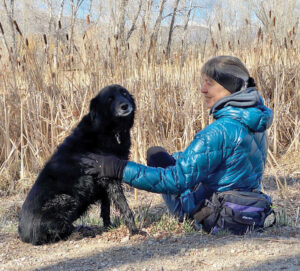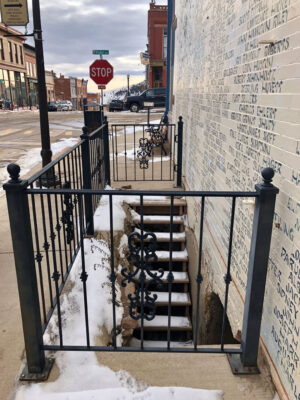By George Sibley
One of Henry Thoreau’s most intriguing lines, in my mind, was his exhortation: “Let us spend one day as deliberately as Nature.” I thought of that one day last week, while following a few public land managers up a gully in an intermittent watershed near Gunnison called Cabin Creek. That quote led, like everything does today, to contemplations on where we’re going in this experiment called America.
Cabin Creek was once a meandering stream in a grassy valley bottom, the grasses yielding to sagebrush as the land sloped up to the brownish-green rolling hills that make up much of the Upper Gunnison River basin. But, some combination of natural and cultural disasters, such as a gully washer storm in the middle of a dry summer, or a little overgrazing transmogrified the meandering stream into the gash of a gully, now six feet deep in places. The water table has been drawn down, allowing the deep-rooted sagebrush to crowd out the water-starved grasses of the meadow. This is a common situation here, and everywhere in the arid West.
The change, from a wet grassy meadow to a dry sagebrush flat, impacted livestock as well as wildlife, including the vulnerable Gunnison Sage Grouse. Many groups in the Upper Gunnison are trying to keep it off the federal Endangered Species list, which would lead to unwanted federal interventions in our economic and cultural lives.
In addition, however, this change was bad for the entire Colorado River system. The earth itself is the best storage unit we have for the water that is so vital to life. Our earth is a “sponge” which, when filled, nurtures life on the surface and slowly releases what’s left into the streams and rivers, extending stream flows later into the summer and fall.
For a region slowly moving into acknowledging long term climate changes toward the hotter and drier, a lot of little things like full sponges in wet meadows can make a difference in water supplies downstream, all the way to California and Nevada, Arizona and New Mexico. Ninety percent of the water in the Colorado River reaching those desert states originates in headwaters watersheds like Cabin Creek.
I’ve been lugging rocks in the headwaters as an occasional volunteer for our Wet Meadows Project for a decade now, and love the work. But mostly, I enjoy eavesdropping on the federal and state agency project designers as they discuss and debate the placement of an array of subtle structures to nudge gully waters toward reconnection with the surface of the land. I pay attention when Bill Zeedyk, the project guru, is in town. He is a wise one who has been studying mountain streams all his professional life, and whose cumulative wisdom is summarized in the title of his book, “Let the Water Do the Work.”
It took us around four hours that day to mosey up about 400 feet of that gully, with frequent discussions about what made the most sense for reversing the spiral of degradation in Cabin Creek. It is spending a day “as deliberately as nature.”
But I don’t want to get lost here in the details of creative strategies for restoring the stream and meadow. Instead I want to fit it into larger concerns confronting all of us today, and my own exhortations in recent columns to think more creatively about what comes next.
What my multi-tasking traffic jam of a mind moved on to that day, was, first, the current pell-mell rush, instigated by the president (an instigator, not a leader), to end the two-month coronavirus pause and hasten to “make American normal again.” Second, the idea that this might be a good time to try to at least clarify which “normal” we wanted to return to.
For example, the current president got elected on a promise to make America as “great” as it was back in the 1950s. Well, in the 1950s, the level of carbon gases in the atmosphere was only around 310 parts per million in the atmosphere, up a little from the 300 ppm it had hovered around for most of our 100,000-year tenure as homosapiens. That’s what was “normal” then, rather than the 400-plus ppm we have today. It’d be great to be back at that 310 ppm normal.
But the 1950s our president wants to get back to was the abnormal post-World War II manufacturing boom, when we “beat our swords into plowshares.” We also created zillions of automobiles, elaborate appliances, airplanes, huge industries to process raw resources into the materials and fuels for all those things, millions of miles of highway, hundreds of coal-fired power plants to keep them running, and on and on, all of it creating lots of well-paying work for lots of people.
That abnormal outburst of consumptive activity is also why the atmosphere is now stoked with a hundred more ppm of greenhouse gases, from bringing banked fossil carbons back into the active carbon cycle, which process fueled the entire abnormal boom. That is why our West is drying out and becoming all but unlivable in some places due to rising temperatures, and why other places will soon become unlivable due to rising seas.
Forget Trump’s abnormal 1950s pipe dream, and the paychecks that have degenerated to a shadow of what they were; 400 ppm, a $10 minimum wage, and a predator economy converting nature’s remaining bounty into landfills and junkyards just to keep people employed. That’s the “new normal” we’re rushing to get back to, mostly because we’re afraid of what might happen if we don’t get that big clanking juggernaut of production and consumption up to speed again, even though we know it is wrecking the planet.
I
sn’t there something else we could be doing, truly meaningful work at living wages that might lend some real dignity to our lives, a sense of improving living conditions on the planet instead of making them worse?
One of the West’s 21st-century creative visionaries proposed an interesting answer to that question 30 years ago, in 1988. At that time, Ed Marston, longtime publisher of High Country News, wrote an anchor essay for a special issue on “the reopening of the Western frontier,” in which he posed the question: “Can the West develop new rural activities to sustain traditional communities?”
He was trying to look beyond the urbanizing West that he himself was all too aware of representing: a gentrified West of lone eagles, retirees and tourism-and-recreation industrialists. Wasn’t there truly a new West that young and old people coming here, actually looking for something different, could engage in? People—well, like me: thinking, back then, that I was retreating from imperial civilization while semiconsciously participating in its conquest?
Marston thought there was an alternative. “One answer, perhaps the only answer, is reclamation: de-roading forests, dealing with ubiquitous mining wastes, recovering overgrazed land, repairing or dismantling dams, pushing out weeds, restoring damaged streams, detoxifying wildlife refuges, and reintroducing wildlife habitat and wildlife.” Were he alive today, I believe he would add to that list: “getting the carbon cycle under control.”
A realistic idealist, Marston immediately noted that the first question always asked was, “How will it be paid for? How can a region, unable to build a stable life when it was high grading mineral deposits and old-growth forests, afford to repair damage caused by extraction of a century’s worth of wealth? The question is backward. The real question is: How can the West not afford restoration?”
He continued, “Once the West decides that the land, streams and, where necessary, the air must be reclaimed, ways to do it will be found. In places, and quietly, that process is underway.” Central Colorado probably has as many exemplars of that process underway as any place in the West. I think of the Wet Meadows restorations here, active conservation easement programs to at least keep land currently used for agriculture out of the urbanization and gentrification process throughout the region, and conservation programs like Chaffee County’s. We are taxing ourselves for most of these projects and programs.
But if, in our three great headwaters, our efforts to conserve and optimize our land and water resources will benefit entire river regions, why shouldn’t all the downriver cities and farms also be putting some funds into the work? (Southern California’s Metropolitan Water District is already partially funding cloud seeding work in the headwaters.)
I know this restoration economy will not fire everyone’s imagination. And the old New West will get its recreation, resort and retirement industries firing again on a few cylinders, as much out of fear of the unknown as from any love for it. Marston knew that too: “The massive work of regional restoration cannot be done with the present Western mindset or skills.” Still probably true.
But, it’s an idea that will still be there when we finally grow into it, a challenge “that will require commitment to change from the bottom up” (Marston). Yes, from the bottom of the gully in Cabin Creek, and thousands like it—incremental, humbling tasks taking fifty, a hundred years, no shortage of meaningful work. Let us spend a century “as deliberately as nature.” We’ll get there. Meanwhile, pick up a hoe or take a hike and rethink “normal.”?
George Sibley prowls gullies and lugs rocks in the Upper Gunnison River headwaters. george@gard-sibley.org
Down on the Ground is sponsored by Tom Arnot and Rae Pederson.


